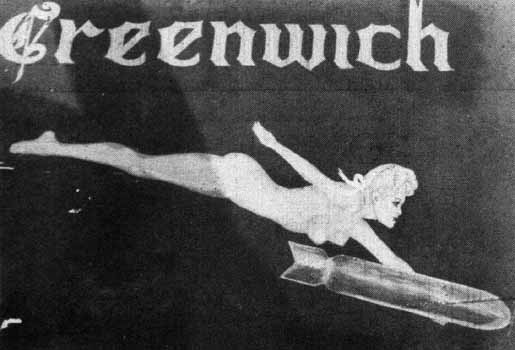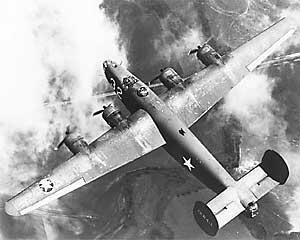Bischofshagen
| Absturzdatum: | 08.04.1944 | ||
| Absturzzeit: | 14:00 Uhr | ||
| Absturzursache: | Abschuß durch Flak | ||
| Flugzeugtyp: | B-24 H-1-CF | ||
| Kennzeichen: | GJ |
||
| Seriennummer: | 41-29153 | ||
| Nickname: | "Greenwich" | ||
| Besatzung: | 10 (10 POW) | ||
| MACR: | 3850 | ||
| Einheit: | 44. BG / 506. BS | ||
| Herkunftsland: | USA |
Gegen 14:00 Uhr an jenem Tag stürzte ein
amerikanischer B-24 Bomber führerlos im Bereich des Ortsteiles
Bischofshagen über freiem Gelände ab. Es wurde nur ein geringer Schaden
angerichtet. Alle zehn Besatzungsmitglieder der Maschine konnten sich
mit den Fallschirmen retten. Sieben sind in Löhne und drei in Rehme
gelandet und kurz darauf festgenommen worden. Sie wurden dem Standort in
Herford übergeben und anschließend an den Fliegerhorst Gütersloh
überstellt.
Der Fliegerhorst in Gütersloh wurde wegen des Flugzeugwracks verständigt
und veranlasste die Abholung. Die Maschine wurde am 13. April 1944 nach
Handorf im Münsterland verbracht.
Die abgestürzte B-24 gehörte einem Verband von 238 amerikanischen
Bombern an, die die Städte Braunschweig, Hannover-Langenhagen und
Fallersleben - heute Wolfsburg - angegriffen hatten. Die Alliierten
verloren bei diesem Einsatz 30 Bomberflugzeuge, davon entfielen auf die
506. Staffel insgesamt fünf Maschinen. Die vier anderen Verluste dieser
Staffel waren:
42-100 423 Pilot Lt Jack M. Winn; 42-110 023 Pilot Lt Ernest A.
Herzing; 42-73 506 Pilot Lt Guy Johnson und 42-109 827 Pilot Lt Dallas
L. Sprinkle.
Startpunkt dieses Einsatzes war der Stützpunkt Shipdham in England. Die
B-24 "Greenwich" flog bis zu ihrem Abschuß insgesamt 42 Einsätze.
Die Besatzung
| P | 2nd Lt Robert H. Marx | POW | Chicago | |||
| CP | 2nd Lt Vernie R. Brockman | POW | Seattle | |||
| Nav | 2nd Lt Leon A. Mascolo | POW | Hartford | |||
| Bomb | 2nd Lt Raymond L. Poljanec | POW | Winston | |||
| TT/ENG | T/Sgt Robert C. Franklin | POW | St.Louis | |||
| RO | T/Sgt Ronald J. Taylor | POW | Dewitt | |||
| BTG | Sgt Edward J. Applegate | POW | New York | |||
| LWG | Sgt Deward F. Johnson | POW | Pelly | |||
| RWG | Sgt Theodore F. Zimmerman | POW | Chicago | |||
| TTG | Sgt Esley E. Nelson | POW | Eugene |

"Nose Art" der B-24 mit der Sereinnummer 41-29153
Auszüge aus dem amerikanischen Bericht über die Ereignisse des Absturzes
"A History of the 506 Bomb Squadron" von Norman C. Kiefer
Sgt Theodore F. Zimmerman berichtet:
| "The entire crew bailed out over a town named Herford, in Germany. Fighters hit us, but what really got us was flak. After we dropped our load of bombs, four 2.000-pounders, we lost an engine and went into a spin. Our two pilots pulled it out at 4.000 feet and hit the horn. We all started to bail out. The ball turret gunner, Applegate, and I were the last to leave. He had to get his shoes and then he lost them when he opened his chute. I guess he did not have time to tie them to his harness. We were captured when we landed. Then we were all sent to Frankfurt for interrogation. From there we went to Stalag 17B, Krems, Austria. The officers went to Stalag I." |
T/Sgt Robert C. Franklin erinnert sich:
| "As I remember, we were hit by flak in the 3 engine putting it out of
commission and caused us to drop out of the formation. It wasn`t but a
few minutes before the 4 engine decided to quit. As you know, the B-24
does not fly too well on two engines, especially on the same side. We went into a spin and I threw the hydraulic switch to get pressure to get the flaps down and open the bomb bay and nose wheel doors open so we could bail out if necessary. We went into a spin but our pilot Bob Marx was able to pull it out and gave the alarm to bail out as he couldn`t hold it very long. As I was floating down, I remember seeing a crowd of people following my descent and were there to greet me on my landing. I was tanken to a house where I was met Lee Mascola, our navigator, and Ray Poljanec, our bombardier. We were then taken to another place were the rest of the crew rounded up. It was good to see that we all had gotten out safely. This was my eighth mission." |
Anmerkung: Die B-24 schlug nur ca. 400 m westlich der Stelle auf, an der die B-17 "Lightning Strikes" ca. 6 Wochen vorher, am → 21.02.1944, niederstürzte.










